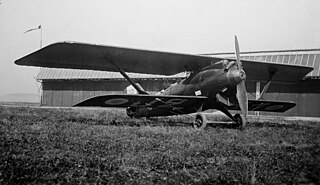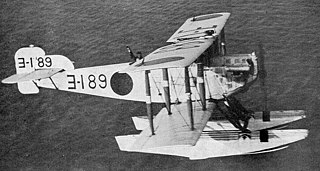
The Breguet XIV or Breguet 14 is a French biplane bomber and reconnaissance aircraft of World War I. It was built in very large numbers and production continued for many years after the end of the war.

The Breguet 19 was a sesquiplane bomber and reconnaissance aircraft which was also used for long-distance flights and was designed by the French Breguet company and produced from 1924.

The Amiot 120 was a family of single-engine biplane bomber aircraft designed and produced by the French aircraft manufacturer SECM-Amiot.
The Lublin R-XX was the Polish torpedo bomber floatplane, designed in the early 1930s in the Plage i Laśkiewicz factory in Lublin. It remained a prototype.
The Potez XV was a French single-engine, two-seat observation biplane designed as a private venture by Louis Coroller and built by Potez and under licence by Podlaska Wytwórnia Samolotów and Plage i Laśkiewicz in Poland.

The Blériot-SPAD S.46 was a small French airliner of the 1920s, developed from the Blériot-SPAD S.33. Like its predecessor, it was a conventional biplane that seated four passengers in an enclosed cabin while the pilot and occasionally a fifth passenger rode in an open cockpit. The S.46 had a redesigned wing of longer span and a far more powerful engine. The type was employed by Franco-Roumaine, which purchased 38 out of the 40 examples produced for use on their continental European routes.

The Blériot-SPAD S.61 was a French fighter aircraft developed in 1923. Designed by André Herbemont, the S.61 was a conventional biplane, abandoning the swept upper wing used by Herbemont in several previous designs. The prototype S.61 was evaluated by the French Air Force alongside the S.51 as a potential new fighter, but like its stablemate, was rejected. The Polish Air Force was impressed enough to order 250, as well as purchase licences for local production. The Romanian Air Force also ordered 100 aircraft. About 30 were built in Poland, by the CWL.

The Nieuport-Delage NiD.62 was a French sesquiplane fighter from the early 1930s. This machine was a descendant of a long line of Nieuport-Delage fighters that were designed and built during the years immediately after World War I. The NiD.62 was built in 1931 as a fighter for the Armée de l'Air. It served until the late 1930s, when it was replaced by more modern monoplane fighters. By the time of the outbreak of World War II in September 1939, all of the NiD.62s had been withdrawn from front-line fighter escadrilles but were used as trainers in French flight schools. A few aircraft were employed as target tugs. After the French German Armistice and German occupation of North and West part of France in June 1940, the German Luftwaffe had no interest in the NiD.62s and they were scrapped. None survived the war.

The Savoia-Marchetti S.59 was a 1920s Italian reconnaissance/bomber flying boat designed and built by Savoia-Marchetti for the Regia Aeronautica.

The Fokker C.VIII was a reconnaissance aircraft built in the Netherlands in the late 1920s. Intended primarily for the photographic reconnaissance role, it was a larger machine than other Fokker reconnaissance types of the period, with space for a third crew member, who acted as camera operator. It was also Fokker's first aircraft of this type to be built as a monoplane, a parasol wing configuration. The construction, however, was in the familiar Fokker style with wooden wings covered with plywood and fabric, and a steel-tube fuselage, also fabric-covered.
The Handley Page HP.14, also designated Handley Page R/200 was a prototype British naval reconnaissance aircraft of World War I, capable of operating from the decks of the Royal Navy's aircraft carriers or as a floatplane. Only three were built, the Parnall Panther being preferred.

The Lioré et Olivier LéO H-13 was a French biplane two-engine flying boat of the 1920s, built in passenger and military variants.

The Nieuport-Delage NiD 42 was a fighter aircraft built in France in the early 1920s, the first in a family of designs that would form the backbone of the French fighter force over the next decade.
PZL.56 Kania (buzzard) was a Polish pre-war project of a fighter aircraft designed by Wsiewołod Jakimiuk of the Państwowe Zakłady Lotnicze. A single-seat low-wing monoplane was a development of PZL.50 Jastrząb fighter, modified to house a Hispano-Suiza 12Y French inline engine.

The Yokosuka E1Y was a Japanese floatplane of the 1920s. A single-engined biplane that was designed and developed by the Yokosuka Naval Air Technical Arsenal as a reconnaissance aircraft for the Imperial Japanese Navy, 320 were built as the Type 14 Reconnaissance Seaplane, entering service in 1925 and remained in operational service until 1932.
The Bréguet 790 Nautilus was a prototype French three-seat coastal patrol flying-boat designed and built by Bréguet Aviation to meet a requirement from the French navy.
The Vickers F.B.24 was a British two-seat fighter aircraft of the First World War. Only a few prototypes were built, as, although it had good performance, the Bristol F.2 Fighter was preferred.

The Nieuport-Delage NiD 120 was a French single-seat parasol monoplane fighter aircraft built during the 1930s. It was built in several versions that were fitted with different engines. Rejected for service with the French Air Force after a fatal crash in 1933, only a dozen aircraft were built for the Peruvian Air Force. Deliveries began at the end of 1934, but the NiD 121s were only service for a few years before a crippling shortage of spare parts after the French aviation industry was nationalized after a series of strikes in 1936. The Peruvian Air Force had exhausted its inventory of spares by early 1939 and the surviving aircraft were scrapped in late 1940.

The Fizir F1V was the basis from which engineer Rudolf Fizir developed a series of single-engined, two-seat, reconnaissance biplanes fitted with different engines. Construction was carried out in the Yugoslav aircraft factories Zmaj and Rogožarski between 1928 and 1932.
The Dewoitine HD.780 was a prototype French fighter-floatplane designed and built from 1938–40. It was a single-seat, single-engined aircraft based on the Dewoitine D.520 land-based fighter. A single example was built but was abandoned unflown, and was scrapped.














